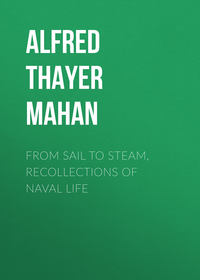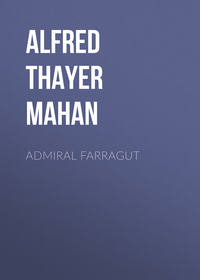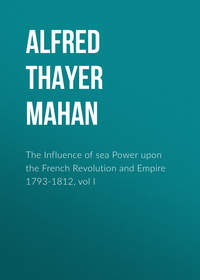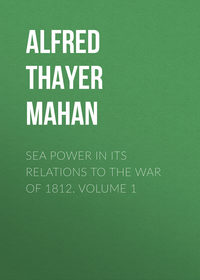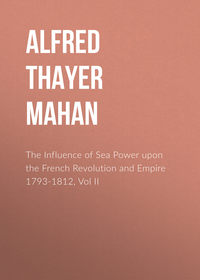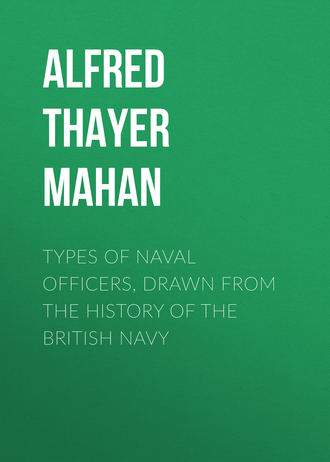 полная версия
полная версияTypes of Naval Officers, Drawn from the History of the British Navy
The thing to be observed here is the separate, but positive, initiative prescribed for a portion of the fleet, with a view to divide the enemy, and then concentrate the whole fleet upon the fraction thus isolated. The British van takes a particular, but not an independent, action; for the other divisions contribute their part to the common purpose. "The middle squadron is to keep her wind, and to observe the motion of the enemy's van, which" [that is, "which" action of the middle squadron] "the last squadron—the rear—is to second; and both of these squadrons are to do their utmost to assist or relieve the first squadron, that divided the enemy's fleet." Evidently here we have tactical combination in order to decisive action; clearly contemplated also beforehand, not merely by a capable individual general, but by the consensus of professional opinion which such a paper as the Fighting Instructions necessarily reflects. The stamp of the galley period is upon this: strenuous and close battle, the piercing of the enemy's order, the movement of the squadrons differentiated, in order that they may in a real and effective sense combine, instead of being merely distributed, as they afterwards were by both the letter of the later Instructions and the tradition by which these became encrusted. Nor should there be overlooked, in this connection, the discretion allowed the centre and rear. They are to "keep their wind;" an expression which leaves optional whether to tack, or stand as they are, whether to engage the separated enemies to windward or to leeward, as occasion may offer, in support of the van. The provisions of 1665 afterwards disappear. In 1740, and even as late as 1781, they are traceable only in certain colorless articles, suggestive of the atrophied organs of a body concerning whose past use physiologists may speculate.
As in the restoration of sounder methods, with which we shall be concerned, this degeneration of ideals was a work of time. In June, 1666, the British met with a severe check in the Four Days Battle, in which Monk, a soldier, commanded in chief. This reverse is chiefly to be attributed to antecedent strategic errors, which made a portion only of the available British force bear the brunt of the first three days; but, among the inevitable criticisms, we find stress laid upon fighting in line as essential to success. This insistence upon the line as an effective instrument proceeded, among others, from Sir William Penn, a seaman, and was at that time in the direction of professional advance. The line had not yet obtained the general professional acceptance needed to establish and utilize its indisputable value. This process was gradual, but when effected it followed the usual laws of human development; from a valuable means, it became in men's estimation an exaggerated necessity. It came to pass in time that the line no longer existed for tactics, but tactics for the line, in which they found their consummation and end.
There intervened, however, a happier period,—one of transition,—and in the third Anglo-Dutch war, 1672-1674, we seem to find a close approach to just proportion between regularity of formation and decisive tactical purpose; in which the principle of the line is recognized and observed, but is utilized by professional audacity for definite and efficient tactical action, aiming at conclusive results. The finest exponent of this, the culminating epoch of naval warfare in the seventeenth century, is the Dutchman Ruyter, who, taken altogether, was the greatest naval seaman of that era, which may be roughly identified with the reign of Charles II. After that, naval warfare was virtually suspended for fifteen years, and when resumed in the last decade of the century, the traces of incipient degeneracy can already be noted amid much brilliant performance. From that time completeness of military achievement became in men's minds less of an object than accurate observance of rule, and in practice the defensive consideration of avoiding disaster began to preponderate over offensive effort for the destruction of the enemy.
In the development of tactical science, the French had played a leading part, as they usually have where reflective mental processes and formal evolution of ideas are concerned. Among admirals, the greatest name of this later period is the French Tourville, a master of the science of his profession, and gifted with a personal courage of the heroic type; while the leading exponent of Tourville's ideas, as well as historian of his achievements, was the French priest Paul Hoste,—chaplain to his fleet, and the father of the systematic treatment of naval evolutions. But with Tourville's name is associated not only a high level of professional management, but a caution in professional action not far removed from timidity, so that an impatient Minister of Marine of his day and nation styled him "poltroon in head, though not in heart." His powers were displayed in the preservation and orderly movement of his fleet; in baffling, by sheer skill, and during long periods, the efforts of the enemy to bring him to action; in skilful disposition, when he purposely accepted battle under disadvantage; but under most favorable opportunities he failed in measures of energy, and, after achieving partial success, superfluous care of his own command prevented his blows from being driven home.
Tourville, though a brilliant seaman, thus not only typified an era of transition, with which he was contemporary, but foreshadowed the period of merely formal naval warfare, precise, methodical, and unenterprising, emasculated of military virility, although not of mere animal courage. He left to his successors the legacy of a great name, but also unfortunately that of a defective professional tradition. The splendid days of the French Navy under Louis XIV. passed away with him,—he died in 1701; but during the long period of naval lethargy on the part of the state, which followed, the French naval officers, as a class, never wholly lost sight of professional ideals. They proved themselves, on the rare occasions that offered, before 1715 and during the wars of Hawke and Rodney, not only gallant seamen after the pattern of Tourville, but also exceedingly capable tacticians, upon a system good as far as it went, but defective on Tourville's express lines, in aiming rather at exact dispositions and defensive security than at the thorough-going initiative and persistence which confounds and destroys the enemy. "War," to use Napoleon's phrase, "was to be waged without running risks." The sword was drawn, but the scabbard was kept ever open for its retreat.
The English, in the period of reaction which succeeded the Dutch wars, produced their own caricature of systematized tactics. Even under its influence, up to 1715, it is only just to say they did not construe naval skill to mean anxious care to keep one's own ships intact. Rooke, off Malaga, in 1704, illustrated professional fearlessness of consequences as conspicuously as he had shown personal daring in the boat attack at La Hougue; but his plans of battle exemplified the particularly British form of inefficient naval action. There was no great difference in aggregate force between the French fleet and that of the combined Anglo-Dutch under his orders. The former, drawing up in the accustomed line of battle, ship following ship in a single column, awaited attack. Rooke, having the advantage of the wind, and therefore the power of engaging at will, formed his command in a similar and parallel line a few miles off, and thus all stood down together, the ships maintaining their line parallel to that of the enemy, and coming into action at practically the same moment, van to van, centre to centre, rear to rear. This ignored wholly the essential maxim of all intelligent warfare, which is so to engage as markedly to outnumber the enemy at a point of main collision. If he be broken there, before the remainder of his force come up, the chances all are that a decisive superiority will be established by this alone, not to mention the moral effect of partial defeat and disorder. Instead of this, the impact at Malaga was so distributed as to produce a substantial equality from one end to the other of the opposing fronts. The French, indeed, by strengthening their centre relatively to the van and rear, to some extent modified this condition in the particular instance; but the fact does not seem to have induced any alteration in Rooke's dispositions. Barring mere accident, nothing conclusive can issue from such arrangements. The result accordingly was a drawn battle, although Rooke says that the fight, which was maintained on both sides "with great fury for three hours, … was the sharpest day's service that I ever saw;" and he had seen much,—Beachy Head, La Hougue, Vigo Bay, not to mention his own great achievement in the capture of Gibraltar.
This method of attack remained the ideal—if such a word is not a misnomer in such a case—of the British Navy, not merely as a matter of irreflective professional acceptance, but laid down in the official "Fighting Instructions." It cannot be said that these err on the side of lucidity; but their meaning to contemporaries in this particular respect is ascertained, not only by fair inference from their contents, but by the practical commentary of numerous actions under commonplace commanders-in-chief. It further received authoritative formulation in the specific finding of the Court-Martial upon Admiral Byng, which was signed by thirteen experienced officers. "Admiral Byng should have caused his ships to tack together, and should immediately have borne down upon the enemy; his van steering for the enemy's van, his rear for its rear, each ship making for the one opposite to her in the enemy's line, under such sail as would have enabled the worst sailer to preserve her station in the line of battle." Each phrase of this opinion is a reflection of an article in the Instructions. The line of battle was the naval fetich of the day; and, be it remarked, it was the more dangerous because in itself an admirable and necessary instrument, constructed on principles essentially accurate. A standard wholly false may have its error demonstrated with comparative ease; but no servitude is more hopeless than that of unintelligent submission to an idea formally correct, yet incomplete. It has all the vicious misleading of a half-truth unqualified by appreciation of modifying conditions; and so seamen who disdained theories, and hugged the belief in themselves as "practical," became doctrinaires in the worst sense.
It would seem, however, that a necessary antecedent to deliverance from a false conception,—as from any injurious condition,—is a practical illustration of its fallacy. Working consequences must receive demonstration, concrete in some striking disastrous event, before improvement is undertaken. Such experience is painful to undergo; but with most men, even in their private capacity, and in nearly all governmental action where mere public interests are at stake, remedy is rarely sought until suffering is not only felt, but signalized in a conspicuous incident. It is needless to say that the military professions in peace times are peculiarly liable to this apathy; like some sleepers, they can be awakened only by shaking. For them, war alone can subject accepted ideas to the extreme test of practice. It is doubtless perfectly true that acquaintance with military and naval history, mastery of their teachings, will go far to anticipate the penalty attaching to truth's last argument—chastisement; but imagination is fondly impatient of warning by the past, and easily avails itself of fancied or superficial differences in contemporary conditions, to justify measures which ignore, or even directly contravene, ascertained and fundamental principles of universal application.
Even immediate practical experience is misinterpreted when incidents are thus viewed through the medium of a precedent bias. The Transvaal War, for instance, has afforded some striking lessons of needed modifications, consequent upon particular local factors, or upon developments in the material of war; but does any thoughtful military man doubt that imagination has been actively at work, exaggerating or distorting, hastily waiving aside permanent truth in favor of temporary prepossessions or accidental circumstance? It is at least equally likely that the naval world at the present time is hugging some fond delusions in the excessive size and speed to which battle-ships are tending, and in the disproportionate weight assigned to the defensive as compared to the offensive factors in a given aggregate tonnage. Imagination, theory, a priori reasoning, is here at variance with rational historical precedent, which has established the necessity of numbers as well as of individual power in battle-ships, and demonstrated the superiority of offensive over defensive strength in military systems. These—and other—counterbalancing considerations have in past wars enforced the adoption of a medium homogeneous type, as conducive both to adequate numbers,—which permit the division of the fleet when required for strategic or tactical purposes,—and also directly to offensive fleet strength by the greater facility of manoeuvring possessed by such vessels; for the strength of a fleet lies not chiefly in the single units, but in their mutual support in elastic and rapid movement. Well tested precedent—experience—has here gone to the wall in favor of an untried forecast of supposed fundamental change in conditions. But experience is uncommonly disagreeable when she revenges herself after her own fashion.
The British Navy of the eighteenth century in this way received an unpleasant proof of the faultiness of its then accepted conclusions, in the miscarriages of Mathews off Toulon, in 1744, and of Byng off Minorca, in 1756. So fixed were men's habits of thought that the lessons were not at once understood. As evidenced by the distribution of censure, the results were attributed by contemporary judges to particular incidents of each battle, not to the erroneous underlying general plans, contravening all sound military precedent, which from the first made success improbable, indeed impossible, except by an inefficiency of the enemy which was not to be presumed. These battles therefore are important, militarily, in a sense not at all dependent upon their consequences, which were ephemeral. They are significant as extreme illustrations of incompetent action, deriving from faulty traditions; and they have the further value of showing the starting point, the zero of the scale, from which the progress of the century is to be measured. In describing them, therefore, attention will be given chiefly to those circumstances which exhibit the shackles under which fleet movements then labored, not only from the difficulties inherent to the sea and sailing ships, but from the ideas and methods of the times. Those incidents also will be selected which show how false standards affected particular individuals, according to their personal characteristics.
In Admiral Mathews' action, in February, 1744, an allied fleet composed of sixteen French ships-of-the-line and twelve Spanish lay in Toulon, waiting to sail for a Spanish port. The British, in force numerically equal, were at anchor under the Hyères Islands, a few miles to the eastward. They got underway when the allied movement began on February 20th; but anchored again for the night, because the enemy that day came no farther than the outer road of Toulon. The next morning the French and Spaniards put to sea with a wind at first westerly, and stretched to the southward in long, single column, the sixteen French leading. At 10 A.M. the British followed, Vice-Admiral Lestock's division taking the van; but the wind, shifting to east, threw the fleet on the port tack, on which the rear under Rear-Admiral Rowley had to lead. It became necessary, therefore, for this division and the centre to pass Lestock, which took some time with the light airs prevailing. Two or three manoeuvres succeeded, with the object of forming the fighting order, a column similar and parallel to that of the enemy, and to get closer to him. When night fell a signal was still flying for the line abreast, by which, if completed, the ships would be ranged on a line parallel to the allies, and heading towards them; consequently abreast of each other. It would then need only a change of course to place them in column, sides to the enemy; which, as before said, was the fighting order—the "line of battle."
The line abreast, however, was not fully formed at dark. Therefore the admiral, in order to hasten its completion, soon afterwards made a night signal, with lanterns, for the fleet to bring-to,—that is, bring their sides to the wind, and stop. He intended thereby that the ships already in station should stand still, while the others were gaining their places, all which is a case of simple evolution, by land as by sea. It was contended by the admiral that Vice-Admiral Lestock's division was then too far to the right and rear, and hence too distant from the enemy, and that it was his duty first to get into his station and then to bring-to. To this the vice-admiral on his trial replied, first, that he was not out of his station; and, second, that if he were, the later signal, to bring-to, suspended the earlier, to form line abreast, and that it was therefore his business, without any discretion, to stop where he was. Concerning the first plea, a number of witnesses, very respectable in point of rank and opportunity for seeing, testified that the vice-admiral did bring-to three or four miles to the right and rear of his place in the line abreast, reckoning his station from the admiral's ship; yet, as the Court peremptorily rejected their evidence, it is probably proper to accept the contemporary decision as to this matter of fact.
But as regards the second plea, being a matter of military correctness, a difference of opinion is allowable. The Court adopted as its own the argument of the vice-admiral. Without entering here into a technical discussion, the Court's ruling, briefly stated, was that the second signal superseded the first, so that, if the vice-admiral was in the wrong place, it was not his duty to get into the right before stopping; and that this was doubly the case because an article of the Night Signals (7) prescribed that, under the conditions of the alleged offence, "a fleet sailing before the wind, or nearly so, if the admiral made the signal for the fleet to bring-to, the windward ships should bring-to first." Therefore, if Lestock was to windward, as the charge read, it was his duty to bring-to first and at once. It is evident, however, that even the Sailing Instructions, cast-iron as they were, contemplated a fleet in order, not one in process of forming order; and that to bring-to helter-skelter, regardless of order, was to obey the letter rather than the spirit. Muddle-headed as Mathews seems to have been, what he was trying to do was clear enough; and the duty of a subordinate was to carry out his evident aim. An order does not necessarily supersede its predecessor, unless the two are incompatible. The whole incident, from Lestock's act to the Court's finding, is instructive as showing the slavish submission to the letter of the Instructions; a submission traceable not to the law merely, but to the added tradition that had then fast hold of men's minds. It is most interesting to note that the unfortunate Byng was one of the signers of this opinion, as he was also one of the judges that sentenced Mathews to be dismissed from the navy, as responsible for the general failure.
During the night of the 21st the allies, who had stopped after dark, appear again to have made sail. Consequently, when day broke, the British found themselves some distance astern and to windward—northeast; the wind continuing easterly. Their line, indifferently well formed in van and centre, stretched over a length of nine miles through the straggling of the rear. Lestock's ship was six miles from that of Mathews, whereas it should not have been more than two and a half, at most, in ordinary sailing; for battle, the Instructions allowed little over a half-mile. Accepting the Court's finding that he was in position at dark, this distance can only be attributed, as Lestock argued and the Court admitted, to a current—that most convenient of scape-goats in navigation. The allies, too, had a lagging rear body, five Spanish ships being quite a distance astern; but from van to rear they extended but six miles, against the British nine. It was the distance of the British rear, not straggling in van or centre, that constituted this disadvantage.
Mathews wished to wait till Lestock reached his place, but the allies were receding all the time; and, though their pace was slackened to enable the five sternmost Spaniards to come up, the space between the fleets was increasing. It was the duty of the British admiral to force an action, on general principles; but in addition he believed that the French intended to push for Gibraltar, enter the Atlantic, and join their Brest fleet, in order to cover an invasion of England by an army reported to be assembling at Dunkirk. Clearly, therefore, something must be done; yet to enter into a general engagement with near a third of his command out of immediate supporting distance was contrary to the accepted principles of the day. The fleet was not extended with that of the enemy, by which is meant that the respective vans, centres, and rears were not opposed; the British van being only abreast of the allied centre, their centre of the allied rear, Lestock tailing away astern and to windward, while the dozen leading French were some distance ahead of both bodies. Now the Fighting Instructions required that, "If the admiral and his fleet have the wind of the enemy, and they have stretched themselves in a line of battle, the van of the admiral's fleet is to steer with the van of the enemies, and there to engage them." There was no alternative course laid down; just as there was no punishment alternative to death in the Article of War under which Byng was shot.
Yet the indications all were that to wait for this most formal and pedantic disposition, which ignored every principle of warfare, would be to throw away the chance of battle. The French, fresh from port and clean-bottomed, out-sailed the bulk of the British, as did the Spaniards, though to a less degree; and it was part of Lestock's defence, admitted by the Court, that, doing his utmost, his division, as a whole, certainly could not get abreast the allied rear. Lestock, indeed, directly submitted to the Court that the commander-in-chief was at fault in not waiting till his line was thus extended and formed, and then all bearing down together, in line abreast; although by his own contention no such issue could have been reached that day, unless the allies were obliging enough to wait. "I aver, and I shall die in this opinion, that no man that is an officer, who knows his duty, will make the signal for line abreast to steer down upon an enemy, until the fleet has been stretched and extended in a line of battle, according to the 19th Article of the Fighting Instructions. Can it be service," he adds, "to bear down so much unformed and in confusion, that the van cannot possibly join battle with, or engage the van of the enemy, the centre with the centre, and the rear with the rear?"
Mathews not being then on trial, the Court in its finding did not reply directly to this question; but indirectly it left no doubt as to its opinion. "The Admiral, by bearing down as he did upon the rear division of the combined fleet, excluded the Vice-Admiral from any part of the engagement, if he could have come up; for if both lines had been closed, when the Admiral engaged the Real, there would have been no more than one ship of the enemy's fleet for the Vice-Admiral and his whole division to have engaged." Again, "It does not appear that the Vice-Admiral was in any part the cause of the miscarriage of his Majesty's fleet in the Mediterranean; the bringing on of the general engagement according to the 19th Article of the Fighting Instructions … not depending upon him." Sixteen officers of the rank of captain and above signed these opinions, and there is no denying the words of the 19th Article; yet one wonders to see no recognition of the necessity of using your opportunity as you find it, of the moral effect of an approaching reserve, which Lestock's division would have constituted, of the part it may take in improving or repairing the results of an action—taking the place of injured friends, preventing injured foes escaping, turning doubtful battle into victory. But no; these commonplaces of to-day and of all time were swamped by the Fighting Instructions. It will be seen in the sequel what a disastrous moral influence Lestock's aloofness exercised upon a few timid captains, and not improbably upon the entire subsequent course and worst errors of his unfortunate superior.




